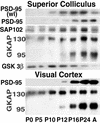Eye opening induces a rapid dendritic localization of PSD-95 in central visual neurons
- PMID: 12552131
- PMCID: PMC298773
- DOI: 10.1073/pnas.0335785100
Eye opening induces a rapid dendritic localization of PSD-95 in central visual neurons
Abstract
The membrane-associated guanylate kinase PSD-95 scaffolds N-methyl-d-aspartate receptors to cytoplasmic signaling molecules, and associates with other glutamate receptors at central synapses. However, regulation of PSD-95 in vivo is poorly understood. We provide evidence of an activity-dependent redistribution of PSD-95 to dendrites in central visual neurons that is tied to eye opening. Six hours after eye opening, increased dendritic PSD-95 coimmunoprecipitates with the same proportions of stargazin, increased proportions of the N-methyl-d-aspartate receptor subunit NR2A, and decreased proportions of NR2B. Sustained high levels of PSD-95 in dendrites are dependent on continued pattern vision in juvenile but not mature animals, suggesting that the stabilization of PSD-95 at synapses may be involved in the control of developmental plasticity.
Figures





Similar articles
-
Developmental loss of miniature N-methyl-D-aspartate receptor currents in NR2A knockout mice.Proc Natl Acad Sci U S A. 2003 Feb 4;100(3):1340-5. doi: 10.1073/pnas.0335786100. Epub 2003 Jan 27. Proc Natl Acad Sci U S A. 2003. PMID: 12552130 Free PMC article.
-
PSD-95 regulates NMDA receptors in developing cerebellar granule neurons of the rat.J Physiol. 2003 Apr 1;548(Pt 1):21-9. doi: 10.1113/jphysiol.2002.034918. Epub 2003 Feb 7. J Physiol. 2003. PMID: 12576494 Free PMC article.
-
PSD-95 involvement in maturation of excitatory synapses.Science. 2000 Nov 17;290(5495):1364-8. Science. 2000. PMID: 11082065
-
Expression of NR2 receptor subunit in rat somatic sensory cortex: synaptic distribution and colocalization with NR1 and PSD-95.J Comp Neurol. 1999 Aug 9;410(4):599-611. J Comp Neurol. 1999. PMID: 10398051
-
Proteostasis in complex dendrites.Nat Rev Neurosci. 2013 Sep;14(9):638-48. doi: 10.1038/nrn3546. Epub 2013 Jul 31. Nat Rev Neurosci. 2013. PMID: 23900412 Review.
Cited by
-
Postsynaptic density 95 controls AMPA receptor incorporation during long-term potentiation and experience-driven synaptic plasticity.J Neurosci. 2004 Jan 28;24(4):916-27. doi: 10.1523/JNEUROSCI.4733-03.2004. J Neurosci. 2004. PMID: 14749436 Free PMC article.
-
Long-term potentiation in the juvenile superior colliculus requires simultaneous activation of NMDA receptors and L-type Ca2+ channels and reflects addition of newly functional synapses.J Neurosci. 2006 Dec 6;26(49):12647-55. doi: 10.1523/JNEUROSCI.3678-06.2006. J Neurosci. 2006. PMID: 17151267 Free PMC article.
-
Posttranslational Modifications Regulate the Postsynaptic Localization of PSD-95.Mol Neurobiol. 2017 Apr;54(3):1759-1776. doi: 10.1007/s12035-016-9745-1. Epub 2016 Feb 16. Mol Neurobiol. 2017. PMID: 26884267 Review.
-
The non-coding RNA BC1 regulates experience-dependent structural plasticity and learning.Nat Commun. 2017 Aug 17;8(1):293. doi: 10.1038/s41467-017-00311-2. Nat Commun. 2017. PMID: 28819097 Free PMC article.
-
Synaptic Ras GTPase activating protein regulates pattern formation in the trigeminal system of mice.J Neurosci. 2006 Feb 1;26(5):1355-65. doi: 10.1523/JNEUROSCI.3164-05.2006. J Neurosci. 2006. PMID: 16452659 Free PMC article.
References
-
- Kornau H C, Schenker L T, Kennedy M B, Seeburg P H. Science. 1995;269:1737–1740. - PubMed
-
- Garcia E P, Mehta S, Blair L A, Wells D G, Shang J, Fukushima T, Fallon J R, Garner C C, Marshall J. Neuron. 1998;21:727–739. - PubMed
-
- Chen L, Chetkovich D M, Petralia R S, Sweeney N T, Kawasaki Y, Wenthold R J, Bredt D S, Nicoll R A. Nature. 2000;408:936–943. - PubMed
-
- Husi H, Ward M A, Choudhary J S, Blackstock W P, Grant S G. Nat Neurosci. 2000;3:661–669. - PubMed
-
- Kennedy M B. Science. 2000;290:750–754. - PubMed
Publication types
MeSH terms
Substances
Grants and funding
LinkOut - more resources
Full Text Sources
Molecular Biology Databases

